A Look At Historical Libertyville
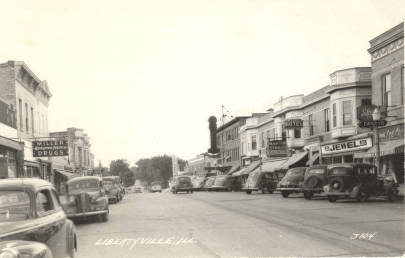
Illinois Digital Archives-Libertyville History
A view of Downtown Libertyville from 1946
“As someone who has studied Libertyville history for years, I really love the fact that our town has the same strong sense of community now, as it did 150 years ago. People who live in Libertyville have always been captivated by her character. I think that’s why you see so many families live here for generations. There is a unique and special excitement Libertyville residents have for our area.”
– Jim Moran, VP of the Libertyville-Mundelein Historical Society and a former DOI reporter
The history of modern Libertyville begins in the early 1830s when English settler George Vardin and his family arrived in what is now Libertyville. The small settlement that soon developed was known as “Vardin’s Grove.” In 1836, during the Independence Day celebration, area residents voted to call their town “Independence Grove.”Mail service from Chicago to Milwaukee was established in 1836, prompting area residents to petition for a post office. The request was granted and the first postoffice was established in the former Vardin cabin (where the Cook House now stands) on April 16, 1837. The Village was also registered under the name “Libertyville” on that day because an Independence Grove post office already existed in the state at that time. The name of the Village was changed again when, with the creation of Lake County in 1839, Libertyville was made the county seat. The new name, “Burlington,” lasted until the county seat was moved to Little Fort (now Waukegan) in 1841. At that time, the Village reclaimed the name “Libertyville.”
Independence Grove
The land was property of the Illinois River Potawatomi Indians until August 1829, when economic and resource pressures forced the tribe to sell most of their land in northern Illinois to the U.S. government. The history of modern Libertyville begins in the early 1830s when English settler George Vardin and his family arrived in what is now Libertyville. The small settlement that soon developed was known as “Vardin’s Grove.” In 1836, during the Independence Day celebration, area residents voted to call their town “Independence Grove.”
Fould’s Macaroni Factory
While it may look abandoned, the Fould’s Macaroni Factory, located on East Church St., is very much in action. It is the factory and headquarters of Fould’s Macaroni Company, which moved to Libertyville from Cincinnati in 1906. The structure, originally a ladder factory, was built in 1894 with timbers from the 1893 World’s Columbian Exposition in Chicago. In its early years, Fould’s was a major employer in Libertyville, well-known for its summer company picnics and winter Christmas parties, to which the whole town was invited.
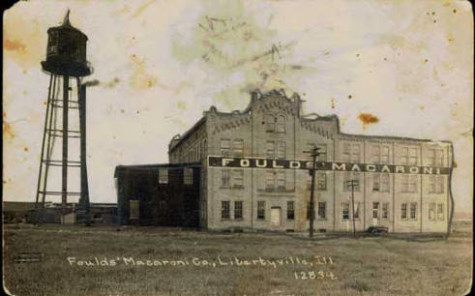 Illinois Digital Archives-Libertyville History
Illinois Digital Archives-Libertyville History
Doddridge Farm (The Gate)
The gate’s history starts with Britton I. Budd, a Chicago railroad executive and president of the Public Service Company, whose wife Katherine was well-known for her work with disadvantaged children. Upon Katherine’s death in 1925, Budd bought 200 acres along the Des Plaines River north of Libertyville for the purpose of building a summer camp for children from St. Mary’s Orphanage in Chicago. The Katherine Kreigh Budd Memorial Home for Children was opened on June 27, 1926. The camp consisted of 15 buildings, including dormitories, a dining hall, a recreation hall, a chapel, an infirmary, an outdoor swimming pool and a playground. Also known as Doddridge Farm, the camp welcomed girls from the orphanage for many years. In 1955, Franciscan brothers repurposed the site as St. Francis Boys’ Camp until 1973. The camp was opened to girls until 1979, when the camp closed for good and the buildings were demolished.
Libertyville One-Mile Race Track
The track opened in 1904 as a harness racing venue. Harness racing is a form of horse racing in which horses race at a trotting pace pulling a two-wheeled vehicle called a sulky. A few automobile races were held there in its later years. Samuel Insull bought the track in 1918 and closed it — reportedly due to his objections to gambling. The heart of the track was located at the intersection of today’s Crane, Carter, and Rockland Roads.
LMHS
Village Hall
Built in 1913, Libertyville’s original village hall was located on West Cook Street. According to local historian Dean Larson, the village hall housed the fire station, jail, meeting rooms and the Alpha Club Library (the forerunner of Cook Memorial Library) in addition to the village offices. When the village moved its offices to the new Schertz Municipal Building on East Cook Street in 1970, the old village hall was almost completely demolished and a new fire station was constructed at the site. In 1994, the village returned to its roots and moved back to its original site after remodeling the fire station into a new village hall.
Cook Library
Local library service began in 1909 when the Alpha Club (now the Libertyville Women’s Club) began a subscription library in Decker and Bond, a local drugstore. The small collection of books soon outgrew the few shelves in the drugstore and in 1914 found a new home in the Libertyville Village Hall. In 1921, the home and property of Ansel B. Cook were left to the village of Libertyville for library and park purposes; Cook Memorial Library opened to the public in November of that year. The first head librarian, Blanche Mitchell, lived with her husband in one of the upstairs rooms of the Cook House.
 Illinois Digital Archives-Libertyville History
Illinois Digital Archives-Libertyville History
Copland Manor School
Copeland Manor School opened in 1957 as a result of the baby boom after World War II.
Public Service Building
The story of the Public Service Building in Libertyville is very much connected with Samuel Insull, founder of the Public Service Company of Northern Illinois, Commonwealth Edison, and owner of numerous banks. In 1907, Insull bought a large acreage south of Libertyville and built and lived in the house now known as the Cuneo mansion. Insull wanted to build a commercial building that would house his bank and promote the potential uses of electricity. To this end, the Public Service Building was constructed in six months in 1928 at a cost of $250,000. The architect, Hermann Valentin Von Holst, had designed many buildings for Insull, including the original Condell Hospital. When the stock market crashed in 1929, Insull lost everything, including the Public Service Building. In the years following, the building and grounds gradually deteriorated due to neglect. Today the courtyard is gone, with a parking lot and bank drive-through in its place behind the building. Despite changes over the years, the Public Service Building remains a town landmark and fine example of unique architecture.
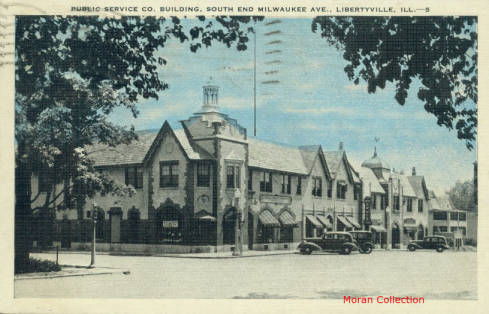 Illinois Digital Archives-Libertyville History
Illinois Digital Archives-Libertyville History
Libertyville Fire of 1895
One night, in 1895, cigar maker Max LeBeau was up late working to finish cigar orders. Around midnight, Max got up from his chair, walked to the front of his shop and looked out the window. What he saw were huge flames leaping skyward in back of Schanck’s Hardware store on the corner of Sprague (now Cook) and Milwaukee (Rolland’s Jewelers, across from Picnic Basket). Max called “Fire! Fire!” rousing many people from their sleep. Bucket brigades quickly formed because there was no fire department. The cause of the fire is unknown to this day.
Liberty Theatre
The Liberty Theatre opened its doors on Aug. 27, 1937. The owner, Fred W. Dobe, first polled the community to determine whether or not Libertyville was satisfied with the existing moving-picture facilities on the second floor of the Gridley Building. When Mr. Dobe was convinced that the area would support a modern theatre, he proceeded with plans for the building. At the time of its opening, the Liberty was admired for its ultramodern design, 700-seat capacity, parking lots and air conditioning. Actor Marlon Brando was employed as a theatre usher for a short time, when he lived in Libertyville between 1939 and 1941.



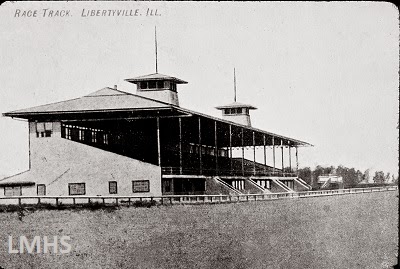
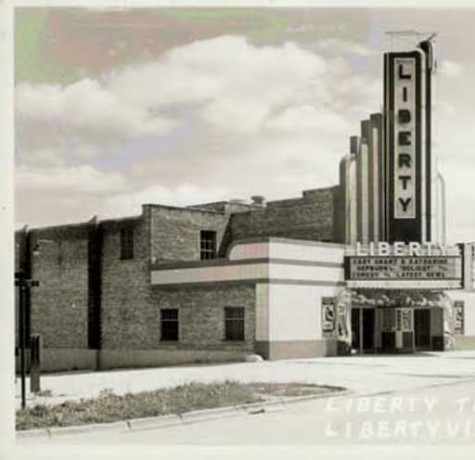


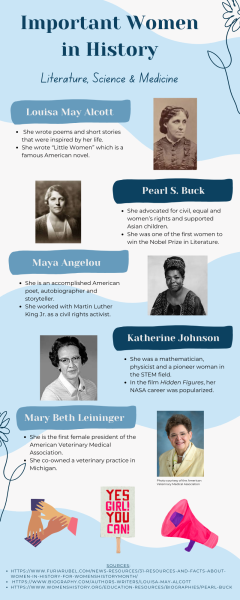
![Mr. Abullh Ali, manager/assistant, helps open Queen Yemeni Coffee in downtown Libertyville at 606 North Milwaukee Ave. With the help of employees such as manager and LHS senior Yousef Taha, they are able to bring the Yemeni and Ethiopian culture to Libertyville by using their Queen spices, cinnamon and cardamom in their drinks such as Adani Chai, which is inspired by Sheda, the Queen of Yemen and Ethiopia. “The history of our coffee [is] a long history and we believe that Yemen and Ethiopia started the coffee and we are bringing something unique to the community,” Mr. Ali said.](https://www.lhsdoi.com/wp-content/uploads/2025/04/Photo-1-600x400.jpg)


